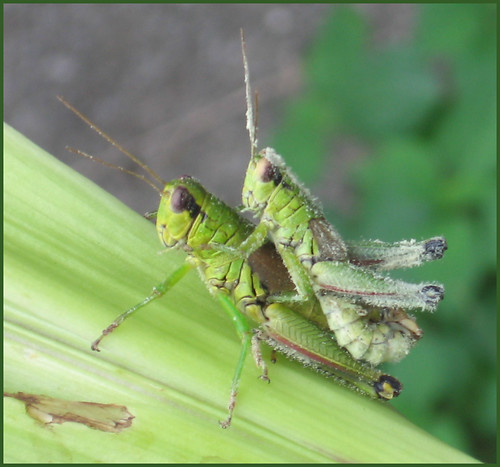
grasshopper is an insect of the suborder Caelifera in the order Orthoptera. To distinguish it from bush crickets or katydids, it is sometimes referred to as the short-horned grasshopper. They also have pinchers or mandibles that cut and tear off food. Those species that make easily heard noises usually do so by rubbing the hind femurs against the forewings or abdomen (stridulation), or by snapping the wings in flight. Tympana, if present, are on the sides of the first abdominal segment. The hind femora are typically long and strong, fitted for leaping. Generally they are winged, but hind wings are membranous while front wings (tegmina) are coriaceous and not fit for flight. Females are normally larger than males, with short ovipositors.

Only one of the 8000 species of grasshopper will only eat a single species of plant.
The digestive system of insects includes a foregut (stomodaeum, the mouth region), a midgut (mesenteron), and a hindgut (proctodaeum, the anal region). The mouth is distinct due to the presence of a mandible and salivary glands. The mandible can chew food very slightly and start mechanical digestion. Salivary glands digest the food chemically, though only carbohydrates in the grasses and such they eat. The mouth leads to the muscular pharynx, and through the esophagus to the crop. The crop has the ability to hold food. From the crop, food enters the gizzard, which has teeth like features in it. From there, food enters the stomach. In the stomach, digestive enzymes mix with the food to break it down.

salivary glands and midgut secrete digestive enzymes. The midgut secretes protease, lipase, amylase, and invertase, among other enzymes. The particular ones secreted vary with the different diets of grasshoppers.
The one closed organ, the dorsal vessel, extends from the head through the thorax to the hind end. It is a continuous tube with two regions: the heart, which is restricted to the abdomen; and the aorta, which extends from the heart to the head through the thorax. Haemolymph is pumped forward from the hind end and the sides of the body through a series of valved chambers, each of which contains a pair of lateral openings (ostia). The haemolymph continues to the aorta and is discharged through the front of the head.


